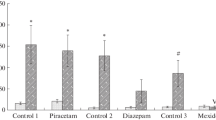Abstract
The administration of (-)3-(3-hydroxyphenyl)-N-n-propylpiperidine (3-PPP) was found to partially, but significantly, suppress the acquisition (4–8 mg/kg IP) and performance (8–16 mg/kg IP) of a conditioned avoidance response (CAR) in male Sprague-Dawley rats. All statistically significant effects were observed within 2 h of injection. Furthermore, using a situation in which the CAR was dependent on a visual successive discrimination, it was shown that discriminative performance was unaffected, and that (-)3-PPP (12.5–25 mg/kg IP) but not (+)3-PPP, suppressed the CAR. When (-)3-PPP (6.25 mg/kg IP) was combined with haloperidol (0.1–0.4 mg/kg IP), additive effects on the CAR performance were observed. Considering these effects, and the doses of (-)3-PPP required to suppress the CAR performance, it is concluded that the effects obtained in the present experiments are primarily due to a blockade of postsynaptic DA receptors.
Similar content being viewed by others
References
Ahlenius S (1974) Effects of low and high doses of l-dopa on the tetrabenazine or α-methyltyrosine-induced suppression of behaviour in a successive discrimination task. Psychopharmacologia 39:199–212
Ahlenius S (1979) An analysis of behavioural effects produced by drug-induced changes of dopaminergic neurotransmission in the brain. Scand J Psychol 20:59–64
Ahlenius S, Engel J (1971) Behavioral effects of haloperidol after tyrosine hydroxylase inhibition. Eur J Pharmacol 15:187–192
Ahlenius S, Engel J (1977) Potentiation by α-methyltyrosine of the suppression of food-reinforced lever-pressing behaviour induced by antipsychotic drugs. Acta Pharmacol Toxicol 40:115–125
Ahlenius S, Svensson L, Hillegaart V, Thorberg O (1984) Antagonism by haloperidol of the suppression of exploratory locomotor activity induced by the local application of (-)3-(3-hydroxyphenyl)-N-n-propylpiperidine into the nucleus accumbens of the rat. Experientia 40:858–859
Andén N-E, Butcher SG, Corrodi H, Fuxe K, Ungerstedt U (1970) Receptor activity and turnover of dopamine and noradrenaline after neuroleptics. Eur J Pharmacol 11:303–314
Angrist BM, Sathananthan G, Gershon S (1973) Behavioral effects of l-dopa in schizophrenic patients. Psychopharmacology 31:1–12
Archer T, Ögren S-O, Johansson G, Ross SB (1982) DSP 4-induced two-way active avoidance impairment in rats: involvement of central and not peripheral noradrenaline depletion. Psychopharmacology 76:303–309
Arnt J, Boegesoe KP, Christensen AV, Hyttel J, Larsen J-J, Svendsen O (1983) Dopamine receptor agonistic and antagonistic effects of 3-PPP enantiomers. Psychopharmacology 81:199–207
Brown F, Campbell W (1984) Comparison of the effects of 3-PPP and its enantiomers on emesis, plasma prolactin levels and CNS dopamine turnover. Br J Pharmacol [Suppl] 81:45P
Carlsson A (1983) Dopamine receptor agonists: Intrinsic activity vs. state of receptor. J Neural Transm 57:309–315
Carlsson A, Lindqvist M (1963) Effect of chlorpromazine or haloperidol on formation of 3-methoxytyramine and normetanephrine in mouse brain. Acta Pharmacol Toxicol 20:140–144
Clark D, Carlsson A, Hjorth S, Engel J, Lindberg P (1983) The effect of the enantiomers of 3-PPP on conditioned avoidance responding in the rat. Psychopharmacology 81:14–17
Corsini GU, Pitzalis GF, Bernardi F, Bocchetta A, Del Zompo M (1981) The use of dopamine agonists in the treatment of schizophrenia. Neuropharmacology 20:1309–1314
Di Chiara G, Porceddu ML, Vargiu L, Argiolas A, Gessa GL (1976) Evidence for dopamine receptors mediating sedation in the mouse brain. Nature 264:564–567
Eriksson E, Modigh K, Carlsson A, Wikström H (1983) Dopamine receptors involved in prolactin secretion pharmacologically characterized by use of 3-PPP enantiomers. Eur J Pharmacol 96:29–36
Goldberg LI, Kohli JD, Glock D (1983) Peripheral dopamine (DA) receptor activity of the enantiomers of 3-(3-hydroxyphenyl)-N-n-propylpiperidine (3-PPP). Fed Proc 42:382
Hjorth S, Carlsson A, Clark D, Svensson K, Wikström H, Sanchez D, Lindberg P, Hacksell U, Arvidsson L-E, Johansson A, Nilsson JLG (1983) Central dopamine receptor agonist and antagonist actions of the enantiomers of 3-PPP. Psychopharmacology 81:89–99
Mikuni M, Gudelsky GA, Simonovic M, Meltzer HY (1984) Interaction of (+) and (-)-3-PPP with the dopamine receptor in the anterior pituitary gland. Life Sci 34:239–246
Niemegeers CJE, Janssen PAJ (1979) A systematic study of the pharmacological activities of dopamine antagonists. Life Sci 24:2201–2216
Siegel S (1956) Nonparametric statistics for the behavioral sciences. New York, McGraw Hill: New York
Strömbom U (1976) Catecholamine receptor agonists. Effects on motor activity and rate of tyrosine hydroxylation in mouse brain. Naunyn-Schmiedeberg's Arch Pharmacol 292:167–176
Svensson L, Ahlenius S (1983) Suppression of exploratory locomotor activity in the rat by the local application of 3-PPP enantiomers into the nucleus accumbens. Eur J Pharmacol 88:393–397
Tamminga CA, Schaffer MH, Smith RC, Davis JM (1978) Schizophrenic symptoms improve with apomorphine. Science 200:567–568
Wålinder J, Skott A, Carlsson A, Roos B-E (1976) Potentiation by metyrosine of thioridazine effects in chronic schizophrenics. Arch Gen Psychiatry 33:501–505
Author information
Authors and Affiliations
Rights and permissions
About this article
Cite this article
Ahlenius, S., Archer, T., Tandberg, B. et al. Effects of (-)3-PPP on acquisition and retention of a conditioned avoidance response in the rat. Psychopharmacology 84, 441–445 (1984). https://doi.org/10.1007/BF00431447
Received:
Accepted:
Issue Date:
DOI: https://doi.org/10.1007/BF00431447




